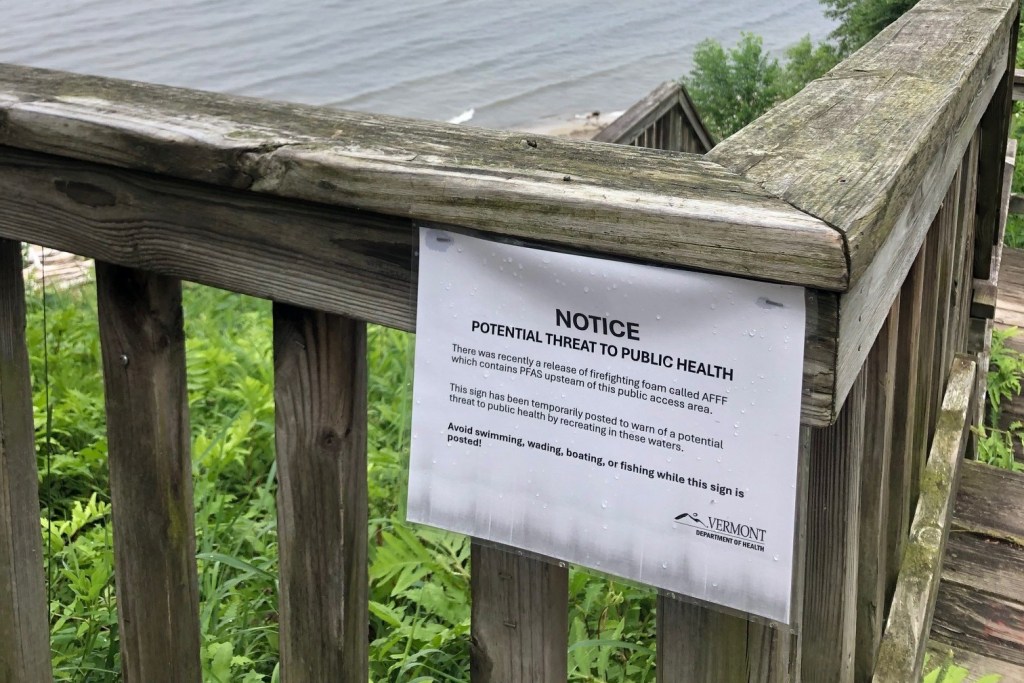Cleanup efforts are still underway after 800 gallons of chemical fire-fighting foam spilled at the Vermont National Guard’s aviation facility in South Burlington.
The building’s fire suppression system experienced a mechanical failure late Thursday night and began releasing the foam. By Friday morning, the foam had leaked into the facility’s drainage system and spread to South Burlington’s wastewater treatment plant.
Concern regarding the severity of the spill rose over the weekend as locals found “no swimming” signs posted along the Winooski River — the river that the South Burlington plant releases treated water into — and Lake Champlain near the mouth of the river. The Vermont Department of Health asked parks in South Burlington, Winooski, Burlington, Colchester and the Winooski Valley Parks District to close their public swimming areas on Friday afternoon, said Sharon Muellers, the department’s senior public health communication officer.
Matt Chapman, director of the waste management and prevention division within Vermont’s Department of Environmental Conservation, said the “no swimming” signs were initially posted “out of an abundance of caution” but will be taken down today now that experts know more about the situation.
The substance that spilled, aqueous film-forming foam, contains a group of synthetic chemicals called per- and polyfluoroalkyl substances. Exposure to these chemicals, commonly known as PFAS, can lead to health problems including developmental defects, cancer, liver problems and decreased immune response.
“We’re actively engaged in responding to the release (of the foam), and I think the public can feel safe about the conditions in the Winooski River,” Chapman said. “But we’re getting data to confirm that right now.”
Chapman said his team’s assessment comes in part from a better understanding of how much of the foam was released into the environment. About 650 gallons were contained inside the aviation facility and only 150 gallons were released into the South Burlington wastewater treatment system, he said.
Chemical foam used to fight fires spills accross the floor of the the Army Aviation Support Facility on Fri., June 21. Video courtesy of the Vermont National Guard
Foam was cleared from the treatment plant on Friday, Chapman said, and there was no “visual evidence” of foam being discharged from the plant into the Winooski River. But “there may be small amounts of dissolved PFAS” that were released, he said. The only way to know is to wait for the results of water quality tests — which won’t be available until later this week, he said.
While the treatment plant itself has already been cleaned, Chapman said, the next step is to clean out the piping of the airport’s wastewater infrastructure to ensure that no more PFAS are tracked into the plant.
Maj. Mikel Arcovitch, the Vermont National Guard’s state public affairs officer, said in an interview that the 650 gallons of foam contained within the Army Aviation Support Facility were removed on Friday by Republic Services, a recycling and waste solutions company based in Williston.
Now, Arcovitch said, Vermont National Guard officials must decontaminate anything that came into contact with the foam, including at least one helicopter. The building will reopen Wednesday, and an investigation of the fire-fighting system that malfunctioned will start Thursday, he said.
The foam system hasn’t been in active use for fire suppression at the facility for about 10 years, Arcovitch said.
“It’s been kind of just sitting in a container, and we’ve been sitting on it, waiting for it to be removed,” he said.
According to the Department of Environmental Conservation’s 2023 PFAS Roadmap, the National Guard facility has needed “ongoing remediation” for PFAS contamination to nearby soils and groundwater due to use of the firefighting foam.
Chapman said that while Vermont has some PFAS regulations in place — including Act 36, which bans PFAS chemicals from being used in fire-fighting foam — they don’t always apply to locations like the aviation facility that are also monitored by the U.S. Department of Defense and Federal Aviation Administration.
The lack of consistency, he said, is a “historic issue” that has long-term implications.
Because PFAS are very stable chemicals — they’re often called “forever chemicals” — they do not break down and can build up in the environment, wildlife and humans over time, according to the Department of Environmental Conservation’s reports on PFAS. The chemicals are also water soluble and mobile, meaning they can travel in water far from where they were initially released, making many drinking water sources vulnerable to contamination.
Chapman said his team will continue to test the Winooski River and land around the airport and wastewater treatment plant in the coming weeks to monitor PFAS levels. But, he said locals shouldn’t be concerned about drinking water at this time: the Winooski River runs at 5,000 gallons per second, he said, making any contamination from the spill “a very small amount” in comparison.
The Department of Environmental Conservation and the Vermont National Guard are expected to release additional updates about cleanup progress and PFAS investigations as more information becomes available.
Read the story on VTDigger here: 3 days after South Burlington chemical spill, cleanup continues.

